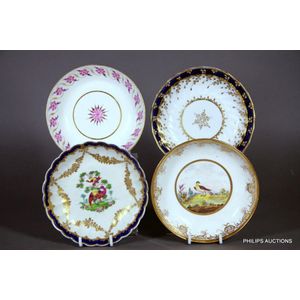Armorials: Plates and Bowl from John Rose Coalport, 1820s
You must be a subscriber, and be logged in to view price and dealer details.
Subscribe Now to view actual auction price for this item
When you subscribe, you have the option of setting the currency in which to display prices to $Au, $US, $NZ or Stg.
- Armorial / Armourial - Bearing a coat of arms. Coats of arms came into general use by feudal lords and knights in in the 12th century, and by the 13th century, arms had spread beyond their initial battlefield use to become a flag or emblem for families in the higher social classes of Europe. They were inherited from one generation to the next. When a family crest is used on individual items of silver or furniture it is an indicator of the aristocratic standing of the family represented.
Armorials were also used to decorate mass produced ceramic souvenir ware by such companies as Goss, Carlton & Shelley, and in these cases the coats of arms displayed were of boroughs and cities. - Circa - A Latin term meaning 'about', often used in the antique trade to give an approximate date for the piece, usually considered to be five years on either side of the circa year. Thus, circa 1900 means the piece was made about 1900, probably between 1895 and 1905. The expression is sometimes abbreviated to c.1900.
- Heraldic Decoration - Heraldic decoration on silver, glass, and porcelain refers to the use of coats of arms and other heraldic symbols as decorative motifs on these materials. Coats of arms were traditionally used to identify individuals, families, and institutions, and were often displayed on shields, banners, and other objects.
The heraldic decoration typically takes the form of engraved or etched designs that incorporate coats of arms or other heraldic symbols. Heraldic decoration on silver, glass, and porcelain has a long history, dating back to the medieval period when coats of arms were first used. During the Renaissance and Baroque periods, heraldic decoration on decorative objects became increasingly elaborate and ornate, with finely detailed designs that often incorporated intricate scrollwork, mythological figures, and other decorative motifs.
In the 18th and 19th centuries, heraldic decoration became particularly popular among the aristocracy and upper classes, who used these objects as symbols of their wealth and status.
This item has been included into following indexes:
- Coalport and Coalbrookdale porcelain (England) - ceramics 526
-
Coalport porcelain (England), item type
- bowls 45
- plates and dishes 165
- Rose, John - Coalport porcelain artist 15
Visually similar items

A Wedgwood dinner service for twelve, 1983-2006, production era, Osborne pattern, comprising seventy two items with dinner, side and cake plates, sweet bowls, cups and associated saucers decorated with sedate floral borders with dots and black bands upon a

Three Rockingham scenic wares: two plates and a dish, 1826-30 period, pattern 558, the three lightly moulded wares in white with gilt chevron borders and a scrolling border to the cavetto, the interior of each with a painted ruin in a landscape scene, one

Four saucers by Chamberlain Worcester, Pinxton, circa 1780s-1810, two items unmarked, a Chamberlain Worcester shanked saucer pattern N.66; a Worcester fluted bowl with a fancy bird, crescent mark underside and an unmarked Worcester saucer; a Pinxton saucer

A Meissen painted exotic birds 15pcs part service, circa mid 19th century, each dish decorated with hand painted exotic bird, scenes surrounded by insects and gilded edge border, the set comprising of 12 plates and 3 graduated
